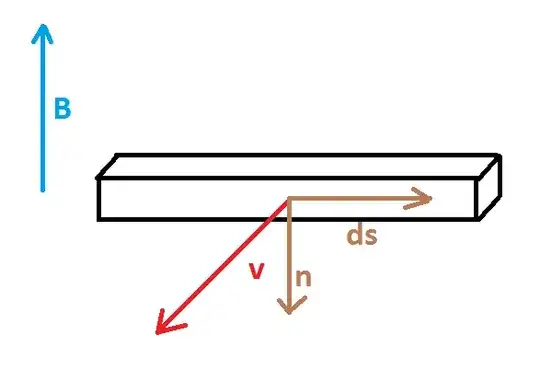I'm confused on how to get Faraday Law from Lorentz Force in the following situation.
Consider a conducting rod moving with velocity $\bf{v}$ in a uniform (constant) magnetic field $\bf{B}$.
I think there are two vectors that must be chosen for the rod: the line vector $\bf{ds}$ and the normal vector $\hat{\bf{n}}$.
I oriented the two vectors in two different ways, but only in the first case I get to the law $$\mathrm{emf}=-\frac{\mathrm{d} \Phi(\bf{B})}{\mathrm{dt}}$$
correctly (i.e. with the minus sign).
I will show the reasoning in the two cases.
In both cases the Lorentz Force is $$\bf{F_L}=\mathrm{q} (\bf{v} \times \bf{B})$$
Which is equivalent to a field $$\bf{E_L}=\bf{v} \times \bf{B}$$
In order to get the $\mathrm{emf}$ I calculate the following integral
$$\mathrm{emf}=\int_{\mathrm{rod}} \bf{v} \times \bf{B} \cdot \bf{ds}=\int_{\mathrm{rod}} \bf{ds} \times \bf{v} \cdot \bf{B}=\int_{\mathrm{rod}} \bf{ds} \times \frac{\mathrm{d}\bf{l}}{\mathrm{dt}} \cdot \bf{B}= \bf{B} \cdot \frac{\mathrm{d}}{\mathrm{dt}}\int_{\mathrm{rod}} \bf{ds} \times \bf{dl}\tag{*}$$ Where $\bf{dl}$ is the infinitesimal displacement in the direction of $\bf{v}$.
Define a vector $\bf{dS}$ that represent the infinitesimal oriented area as $$\bf{dS}=||\bf{ds} \times \bf{dl}||\,\,\, \hat{\bf{n}}$$
And let $\bf{S}$ be the total oriented area, that is $$\bf{S}=\int ||\bf{ds} \times \bf{dl}||\,\,\, \hat{\bf{n}}$$
The two cases (with different orientation for $\hat{\bf{n}}$ and $\bf{ds}$) are different if I continue to work on expression $(*)$.
Case 1
Let the vectors be oriented as in picture
In this case $$\bf{ds} \times \bf{dl}=-\bf{dS}$$
Therefore $$\mathrm{emf}= \bf{B} \cdot \frac{\mathrm{d}}{\mathrm{dt}}\int_{\mathrm{rod}} \bf{ds} \times \bf{dl}=-\bf{B} \cdot \frac{\mathrm{d}}{\mathrm{dt}} \bf{S}=-\frac{\mathrm{d}}{\mathrm{dt}}(\bf{B} \cdot \bf{S})=-\frac{\mathrm{d\Phi} (\bf{B})}{\mathrm{dt}} $$
Case 2
Let the vectors be oriented as in picture
In this case $$\bf{ds} \times \bf{dl}=+\bf{dS}$$
Therefore $$\mathrm{emf}= \bf{B} \cdot \frac{\mathrm{d}}{\mathrm{dt}}\int_{\mathrm{rod}} \bf{ds} \times \bf{dl}=+\bf{B} \cdot \frac{\mathrm{d}}{\mathrm{dt}} \bf{S}=+\frac{\mathrm{d}}{\mathrm{dt}}(\bf{B} \cdot \bf{S})=+\frac{\mathrm{d\Phi} (\bf{B})}{\mathrm{dt}} $$
In Case 2 I do not get the proper minus sign: how can that be? Is there something wrong in what I have tried? In particular, is there any rule for which it is not correct to set the vectors oriented as in Case 2?





